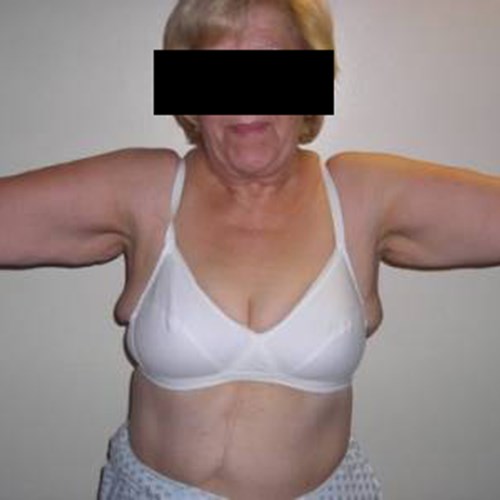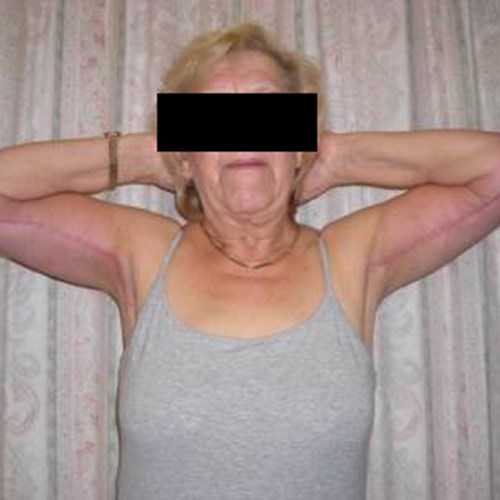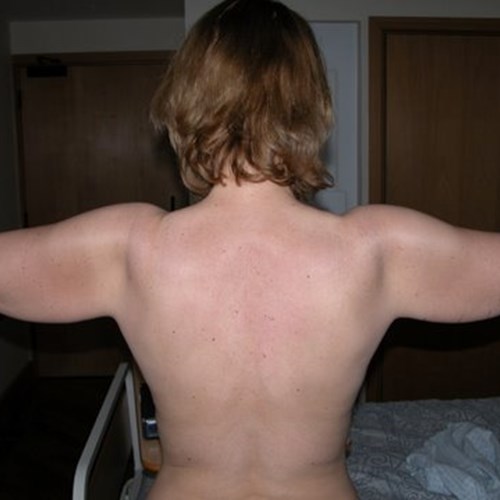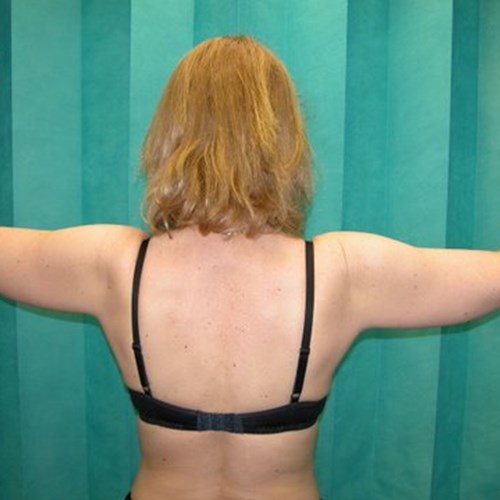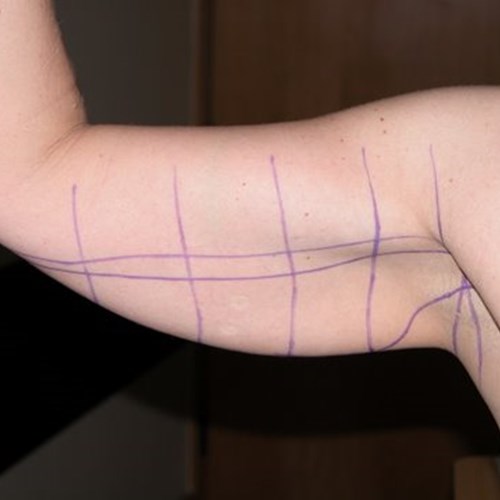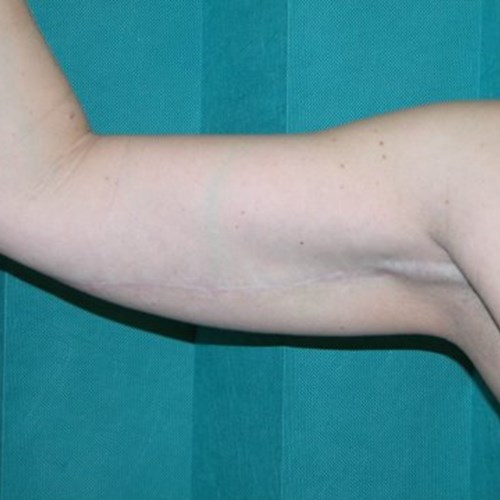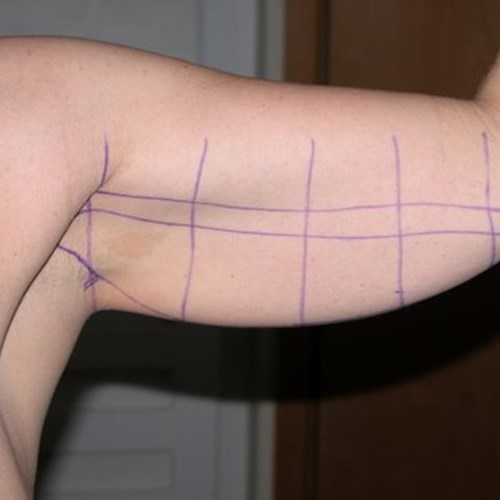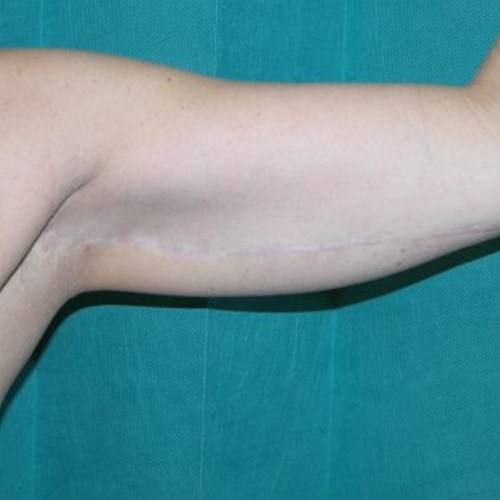Brachioplasty is usually performed under general anaesthesia and usually requires an overnight hospital stay. A wedge or ellipse of skin and fat is excised from the inner arm leaving a scar that can run from axilla to elbow. The scar can sometimes be shorter if you need a mild lift only. It can also be longer and incorporate the removal of lateral chest fullness – e.g. in massive weight loss patients. In addition liposuction can be performed to the arm, which is used to de-fat the area being treated before the skin is excised. This technique helps to minimize damage to superficial nerves and lymphatics.
What can be expected at the initial consultation?
At the initial consultation you will be assessed as to whether you are a good candidate for brachioplasty. Your arms will be carefully examined to assess the amount of excess skin and fat. Your general fitness for the procedure will be evaluated and the potential for problems sought. It is important to know about past medical problems, medication that you are on, and whether or not you smoke.
Your reasons for wanting the procedure will also be discussed. It is important that your expectations concerning the outcome of the procedure are realistic. If they are, you can expect to be happier with the result.
Once you have been fully assessed, an operative plan tailored to your individual needs will be formulated. The incision to be used, the amount of skin and fat to be excised, and whether liposuction will be used as an adjunct will be discussed with you.
Do not be hesitant to ask questions, now or at any other time.
Medical aids or health insurance companies do not usually provide cover for this kind of surgery although occasionally a motivation can be done especially if you have lost large amounts of weight.
Preparing for surgery
Ideally surgery is performed when you are fit and healthy. No special diet or exercise program is required prior to brachioplasty, but you should be close to your ideal weight. It is a good idea to have a good fluid intake for a few days before your operation. You should not have been on a long-haul flight for 2 weeks prior to surgery
It is advisable to stop smoking at least 6 weeks prior to surgery and not to smoke until your wounds have healed - usually about 6 weeks after the operation. It is well known that there is a higher frequency of complications in patients who smoke. In ex-smokers although the risk of complications is lower, it never reaches the levels of those who have never smoked.
On the morning of surgery you should wash well. Do not shave your axillary hair specifically. Prior to surgery, the incision lines will be marked with a pen in your room. Mr Soldin usually takes photographs for your records immediately before surgery.
The Surgery
Surgery will be performed in an operating theatre under general anaesthesia. A brachioplasty takes between one and three hours. Following surgery the wounds are closed with dissolving sutures, and drains may well be left in place for a day. Dressings will be applied, and an elasticated garment will be needed. A tubigrip is usually placed over the dressings for the first few weeks, but Mr Soldin recommends MACOM garments to be used for six weeks or more after the surgery. These can be purchased over the internet with delivery time about 48hrs.
What can be expected after the operation?
Following the operation you should be relatively pain free, although you may feel some discomfort with movement. You will be given analgesic tablets to take regularly. Daily showers are encouraged. Someone will need to drive you home and help around the house for a few days. You will be given painkillers to take home with you. The drains, if needed, are usually removed before you go home.
How long does it take to get back to normal?
Healing is a variable process and it may take you 4 weeks to feel like your old self again. People vary enormously in their recovery period.
The scars are healing well by the end of the first week, but continue to mature for up to a year, by which stage they should be thin, fine, inconspicuous lines. It must however be remembered that much of wound healing is out of the control of the surgeon, and abnormal unsightly and uncomfortable scars can occur. Massage of the scars with an aqueous cream helps, but should only be started after 1 month.
Bruising takes about 2 weeks to settle. Swelling can take up to 12 weeks or longer to settle. To help diminish swelling and bruising tubigrip support should be worn for 24 hours a day.
Mobilisation should be gentle, but begun early. Vigorous exercise should be avoided for six weeks, until you feel comfortable – your body will tell you if you are pushing it too hard. Do not drive until you really feel well – usually 2 weeks. Shower daily to stay clean.
Depending on the procedure you have, you may be able to begin work after about 1 week (liposuction), and 2-4 weeks for a full brachioplasty.
What are the risks?
When performed by a qualified plastic surgeon, brachioplasty is normally safe and the results predictable. Nevertheless, as with any surgery, there is always a possibility of complications, including the following:
Prolonged swelling – this may include disruption to some of the lymphatic channels along the inner arm. This condition is called LYMPHOEDEMA and may require prolonged elasticated support. Fortunately this is uncommon (<5%) and also mild.
Sensory alterations in the area - numbness occurs in nearly all patients because small skin nerves are cut during the surgery. It is usually transient. Can take up to 2 years to resolve. Occasionally sensation abnormalities can be permanent and also affect the forearm as cutaneous nerves that supply sensation to the skin of the forearm pass through the operated area and can be damaged during surgery.
Bleeding (<5%), which can lead to fluid collection. These may require drainage with a syringe or, repeat open operation to remove a haematoma.
Infection at the operative site ( <2%) or elsewhere (e.g. pneumonia)
Loss of tissue ( necrosis ) - Usually small and treated with dressings. May need return to theatre for removal of tissue. Fortunately this is rare ( <1% ).
Unsatisfactory scarring - usually not keloid, but scars can stretch or become raised and red and uncomfortable. This may require further treatment in the form of massage, creams, steroid injections or even revisional surgery.
Asymmetries or irregularities in contour, the commonest being dog-ears at the ends of the scars. These may require simple revision under local anaesthesia.
Clots in the legs which can migrate to the lungs. Pulmonary emboli are rare after surgery, but can result in death. Early mobilization, staying well hydrated, using compression stockings, and heparin injections all lessen the risk.
Problems with anaesthesia, drugs, etc. These should be rare and the risks will be explained to you by your anaesthetist.
Prolonged recovery if any of the above occur.
Dissatisfaction with the surgery.
Will the new look last?
Brachioplasty produces excellent results for patients with hanging upper arm skin and fatty excess. In most cases the results are long lasting ( 10 years or more ), especially if after the operation you avoid weight gain, follow a balanced diet and exercise regularly.
Checklist before coming into hospital
Bring all your usual medication, toiletries and pyjamas.
No smoking (6 weeks), and no aspirin (2 weeks) before the operation
If you are worried post-operatively
Telephone the ward of the hospital from which you have been discharged.
Telephone my secretary Angie Harrison during office hours – 07961221874
In an emergency (and you have failed to contact me by the above two methods) then please telephone St George’s Hospital (020 8672 1255) and ask them to either bleep me or the Resident Plastic Surgery doctor on call (Bleep 7050).
